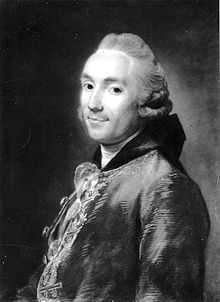Jean-Joseph de Laborde
| Laborde | |
|---|---|
 Jean-Joseph de Laborde | |
| Born |
1724 near Jaca in Aragon |
| Died |
18 April 1794 (aged 70) Paris |
| Occupation | French politician |
Jean-Joseph, marquis de Laborde (1724 – 18 April 1794) was a French politician.
Biography
Laborde was born near Jaca in Aragon, into a modest béarnaise family.[1] When he reached adolescence he joined his uncle, who was head of a maritime import-export company at Saint-Jean-de-Luz, and took over as head of the business on the cousin's death. He based his subsequent fortune not only on this company, but also on transatlantic trade (supplying the American colonies with basics, in return for far more financially interesting products such as tropical fruits, rare trees and slaves) and his sugar plantations on Saint-Domingue (Haïti).
His dazzling rise, comparable to that of several bourgeois men of the age of Enlightenment, gained him promotion to noble rank and allowed him to acquire several estates. He became fermier général (1759–1767) on the suggestion of his friend the duc de Choiseul. He took up residence in the château de La Ferté-Vidame in 1764, redecorating it to his taste and commissioning several artists. However, following a game of musical chairs, he lost it in 1784 to the duc de Penthièvre, who had himself lost his domaine de Rambouillet to king Louis XV, who coveted its "terres giboyeuses" or wooded hunting lands. Laborde was named marquis and in 1784 acquired the castle of Méréville, rebuilding it to his taste.
In politics, he was ahead of his time and of the French Revolution, and (with Mirabeau) was one of the only noble députés (from the bailliage d'Étampes) to accept demotion to the Third Estate upon the Revolution. However, this was not enough to save him from being guillotined under the "loi des suspects" on the orders of Louis de Saint-Just, in one of the last fits of the Reign of Terror in May 1794. In 1792 much of the fabulous Orleans Collection of paintings was briefly his, before he was forced by events to abandon his ambition to exhibit them in his Paris house, and sold them.
Laborde died in 1794 in Paris.
Descendents
- Edouard-Jean-Joseph de Laborde Marchainville (1762-1786), a member of the Lapérouse expedition, who drowned, along with his brother, in Lituya Bay, Alaska[2]
- Pauline de Laborde (1765–1782), married Jean-François Pérusse, 1st duc des Cars
- Ange-Auguste-Joseph de Laborde Boutervilliers (1766-1786), a member of the Lapérouse expedition, who drowned, along with his brother, in Lituya Bay, Alaska[3]
- Nathalie de Laborde (1774–1835), married Charles de Noailles, duc de Mouchy, was la petite mouche among the many mistresses of Chateaubriand
- Alexandre de Laborde, archaeologist, soldier and politician, who continued his father's Revolutionary political views
See also
Notes
- ↑ His father carried mullet and smuggled Spanish piastres on his back over the Pyrénées - M. Bruguière L'aristocratique descendance des affairistes de la Révolution p 106.
- ↑ Dunmore, John (1994). The Journal of Jean-François de Galaup de la Pérouse, 1785-1788, Vol. 1. London: The Hakluyt Society. p. lxxiii. ISBN 0904180387.
- ↑ Dunmore, John (1994). The Journal of Jean-François de Galaup de la Pérouse, 1785-1788, Vol. 1. London: The Hakluyt Society. p. lxxii. ISBN 0904180387.
Sources
- Boyer, Ferdinand (1954). "Jean Joseph de Laborde, protecteur de F.X. Fabre et sa collection confisquée en 1794". Bulletin de la société d'histoire de l'art français.
- Bronne, Carlo (1968–69). "Un couple brillant, les Laborde". La Revue de Paris (Paris).
- Delmas, Jean-François (1988–1989). Le Mécénat des financiers au XVIIIe siècle. Les collections de peinture de Jean-Joseph, marquis de Laborde. Paris,: Paris-Sorbonne.
- Durand, Yves (1968–69). "Mémoires de Jean Joseph de Laborde, banquier de la cour et fermier général". Bulletin de la société d'histoire de France.
- Dussau, A.J. "Jean Joseph Laborde, négociant bourgeois bayonnais, banquier du roy, victime de la Terreur". Bulletin de la société des sciences, lettres et arts de Bayonne, 1967.
- Thomas, Jean-Pierre (2002). Jean-Joseph de La Borde : banquier de Louis XV, mécène des Lumières. Paris: Perrin.